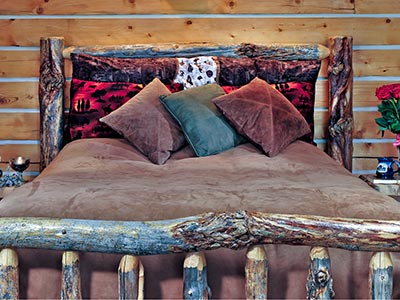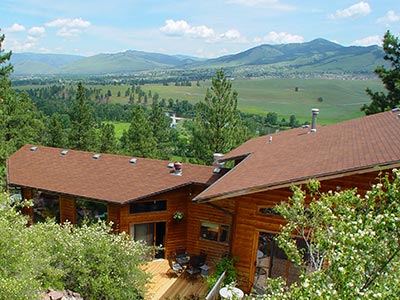Springtime is truly beautiful here at Blue Mountain Bed and Breakfast in Missoula, Montana. The wildflowers bloom from late March through early July. Their significance is linked to Montana’s Native people in a variety of ways. The following six plants are basically found during the second wave of blooming here on the mountain (April-May).
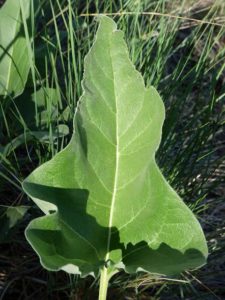
The following activity is a fun way for Montana students (or anyone) to learn more about Montana’s native plants and people.
Directions: Use the Photos, I.D. Clues and Fun Facts to help you identify each plant by name.
WORD BANK: To which photo and clues do I belong? (Answers at the very bottom of the page, by number)
1. Arrowleaf Balsamroot (Balsamorhiza Sagittata)
2. Arnica (Arnica Montana/Chamissonis)
3. Chokecherry (Prunus Virginiana)
4. “Indian” Paintbrush (Castilleja linariaefolia)
5. Western Pasqueflower (Anemone patens or nuttalliana)
6. Wild Lupine (Lupinus Angustifolius)
Let’s Begin…
A. Can you name me? (1, 2, 3, 4, 5, 6)
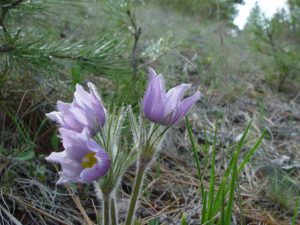
I.D. Clues:
-I have 5-6 large bluish-purple petals, ferny leaves and am soft to the touch.
-I only have 1 flower per stem and am about a foot tall.
-I bloom after the buttercups and shooting stars, but before the Arnica, Lupine and Chokecherry.
-I come in eight different species here in the western U.S..
Fun Facts:
-I am South Dakota’s state flower and am often called by the name of prairie crocus.
-I contain alkaloids that can irritate your skin and digestive track.
-Native people have used me for various things. The Blackfeet made a poultice out of me to cure wounds.
The Blackfeet honor me with the name Napi or Old Man (cultural hero, creator, sometimes trickster). (“Pasque Flower”)
-My name “Pasque” comes from an old French word for Easter. In some places I bloom near Easter and was once used to color Easter eggs. (“Pasque Flower”)
-After I’m done flowering, I grow a silky “head of hair” which has given me the nickname “Old Man of the Mountain.”
B. Can you name me? (1, 2, 3, 4, 5, 6)
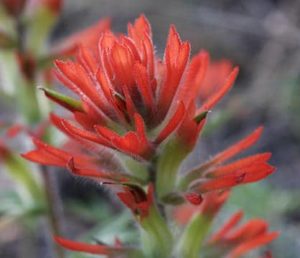
I.D. Clues:
-I am between 15-60 cm tall.
-I come in about 200 different species which means there are many shades and varieties of me. Often it’s hard to tell each a part.
-I am called by many different common names. Most describe my brilliant color in some way or hint at me being similar to a tool an artist might use.
-One of my names is shared with a colorful butterfly known as the Painted Lady.
-My other names include painted cup and prairie fire since I’m often a bright red, redish-orange or redish-pink color.
Fun Facts:
-You can find me from 1,000-3,00 feet in elevation- as far north as Alaska or as far south as the Andes mountains in South America.
-I am Wyoming’s state flower.
-I am pollinated by hovering insects and humming birds that don’t need a place to sit or land while feeding.
-My actual flowers are hidden by brightly colored bracts which are usually tender and sweet to eat.
-In Glacier Park, I am sometimes found sporting a pinkish-violet color. Once in a while I’m even found dressed in white.
-My roots and green parts can be toxic so some Native people mixed my edible parts with other greens or ate parts of me in moderation.
-Some Native people used me as a source of dye.
-The Chippewa used me to treat rheumatism (joint and muscle pain).
– Several tribes, including the Blackfeet, made a rinse from me so they would have glossy hair.
-When I grow in soil that is high in selenium, I can be toxic.
-I’ve earned a name as a parasitic plant because I can steal the nutrients from the roots of other plants. (Craighead, Craighead, and Davis 170)
-I like to live near lupine and sage brush because I can take on their alkaloid properties. That way, I taste bitter to animals like deer.
C. Can you name me? (1,2,3,4,5,6)
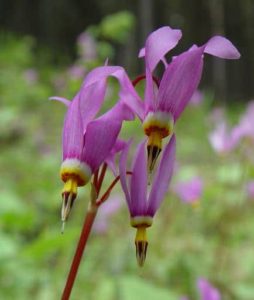
I.D. Clues:
-I am a type of large, wild sunflower.
-I bloom in late spring to early summer and am found in the western states (Oregon, Montana, Colorado, etc.)
-I have a long stem that measures 20-60 cm tall.
-You often find me in sunny, open areas and often under ponderosa pine trees.
-My leaves are large and to some people look like a spear point.
Fun Facts:
-Every part of me can be eaten. The Salish, Kootenai and Nez Perce people peeled my immature flower stems. They then ate the tender inner portion like one would eat celery, raw. (Hart 37)
-My large, starchy roots are big and full of sticky sap. Native people in the area crushed my roots, taking out the fibrous material and then used the rest. The root was sometimes burned as incense. If eaten raw, my roots can make a person feel nauseated. The same thing is true if one drinks too much tea made from my roots.
-My large leaves were often used to wrap around Camas bulbs for cooking. Leaf tea was used as a wash for poison ivy.
-Certain Native tribes would grind my seeds into a type of flour. (Kershaw, MacKinnon, and Pojar 238)
-My roots or other parts were dried, steamed or baked in a roasting pit or cooked over an open fire.
-One name given to me by the Blackfeet was Ohm-ah-gahs (big turnip). (Johnston 56)
-I’ve been used to make many oral as well as topical medicines for headaches, insect bites, wounds and other things.
D. Can you name me? (1,2,3,4,5,6)
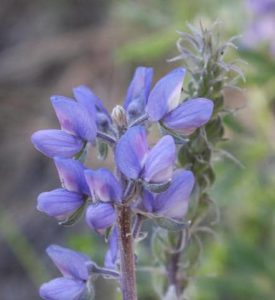
I.D. Clues:
-I grow wild, but am related to a tall garden flower that comes in many colors.
-I bloom from April to July depending on the location.
-Each of my leaves looks a bit like a Palm tree and is broken up into 5-9 finger-like segments.
-My flowers are pea shaped and about 1 cm long.
-My Latin name “lupus” means wolf. People used to think I stole important minerals from soil. (They compared it to wolves that sometimes take livestock from a ranch for food.) In truth, I put nitrogen into the soil and actually leave it richer than before.
-There are about 600 species or variations of me out there. In the wild, I am usually found to have blue and purple hues.
Fun Facts:
-I’m an important food source for the larva of a rare type of blue butterfly.
-I’m known to be one of the top ten most important wild flowers for native bees. Humming birds and marmots like me too.
-I am found in many states across the U.S. and can also be found in Canada.
-In certain quantities I am toxic to domestic animals and have been known to kill sheep.
-I am not toxic to white-tailed deer and certain other wildlife species. (“Montana Fish, Wildlife & Parks :: Silky Lupine”)
-Some Native American tribes fed me to their horses and said it fattened them up, gave them energy and spirit.
-Several Native tribes used my leaves to brew tea. After the tea cooled, it was given to a person who had an upset stomach.
-If a person eats too much of me, her or she can get sick. In large quantities, a person will have convulsions, go into a coma and can die from me.
E. Can you name me? (1,2,3,4,5,6)
I.D. Clues:
-I am made up of a single stem and get to be 10-60 cm tall.
-My stems and my heart-shaped leaves feel slightly fuzzy.
-I am a type of sunflower, but smaller in size compared to most.
-I like to grow alongside others. Together, we blanket small areas of fairly shady, moist, forest or meadow areas in yellow.
Fun Facts:
-In the Blackfeet language, I’m called Ota-kap-is-chis-kit-sima which means yellow flower.
-All of my plant parts are poisonous and I should not be eaten. My flowers are the most potent part and cause a person’s body temperature to rise.
-Some people have used extracts of my flower for hair growth.
-My roots and flowers have been used by some to make washes, salves and poultices for the healing of sprains and swollen feet.
-No part of me should be applied to broken skin areas since I’m very toxic. (Kershaw, MacKinnon, and Pojar 242)
-Mule deer like to eat me while they graze.
-You can find me blooming in late May or even into August depending on the locations.
F. Can you name me? (1,2,3,4,5,6)
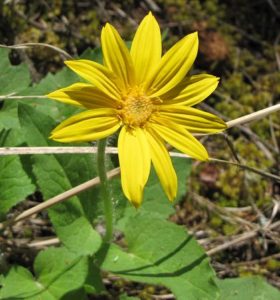
I.D. Clues:
-I am considered to be a bush, shrub or tree of medium height but can get up to 25 ft. tall.
-My stocks are green, brown or redish-brown depending on the time of year.
-My leaves are light green in the spring and turn to a darker green in fall.
-I have strong, but sweet smelling off-white flowers that bloom in the spring (May-June).
-Each flowering clump is thick, elongated and made up of many small flowers.
-In late summer and in the fall, I grow berries that turn from red to almost black when they ripen.
-My single berries hold one seed, grow in strands and are about the size of a large huckleberry.
-My common name reflects the fact that my berries are bitter (they can make a person pucker, even when ripe.)
-My leaves and especially my single seed “cherry” pits are toxic to some animals if eaten raw.
-The Salish, Kootenai, Gros Ventre and Crow Indians made a tea from my bark for stomach ailments. (Hart 88)
Fun Facts:
-In late summer and fall, bears love to pull my branches to the ground and eat my berries.
-In Western Montana, I flower in May and early June- right after the white Serviceberry bushes, but a bit before the white, lovely smelling Syringa.
-I am in the rose family. Like the berries from wild roses (rose hips), my berries are an important source of vitamin C. My berries should be dried or boiled to rid them of their toxicity before being used to make food.
-I was dried and then pounded into a flour-like material, stored in cakes and later used in soups or added to pemmican by certain tribes. Pemmican (a mixture of fruit, meat and fat) was an important food source during the winter months.
-Many Plains tribes used my berries to make a red dye. My bark was used as a green dye and also soaked in water and used to treat coughs and sore throats.
-My forked sticks were used to carry hot rocks for the purpose of cooking. The rocks were dropped into animal skin bags filled with water which would then boil.
-My sticks were also used to roast wild game. My wood does not burn or break easily and adds spice to cooking meat. Some tribes used my sticks in tipi and bow making.
You can check your wild flower naming accuracy below under Answers.
If you enjoyed this activity, take a few photos of wild plants and come up with your own clues. If you need some reference ideas, please look at the bottom of the page.
Each of our rooms, here at Blue Mountain B&B, is named after an important plant in the area. Click on the following link to learn more about our Missoula Bed and Breakfast.
PHOTO CREDIT: Room photos taken by Marcus Berg @uniqueanglesphotography, all others by Blue Mountain Bed and Breakfast.
Questions or Comments: Please email us: stay@bluemountainbb.com
Answers in order: (5, 4, 1, 6, 2, 3)
References:
Anderson, David. Wildflowers of the Rocky Mountains Pocket Flower Guide to Popular Varieties. N.p.: n.p., n.d. Print.
Blank, D. Linnell. Montana Wildflowers. Helena, MT: Farcountry, 2005.
Craighead, John Johnson, Frank C. Craighead, and Ray J. Davis. Rocky Mountain Wildflowers from Northern Arizona and New Mexico to British Columbia. Norwalk, CT: Easton, 1985.
Foster, Steven, and Christopher Hobbs. A Field Guide to Western Medicinal Plants and Herbs. Boston: Houghton Mifflin, 2002.
Gabel, Audrey, and Elaine Ebbert. Mushrooms and Other Fungi of The Black Hills And Surrounding Area. Spearfish: Black Hills State UP, n.d. Print.
Hart, Jeff. Montana–native Plants and Early Peoples. Helena: Montana Historical Society, 1992.
Johnston, A. Plants and the Blackfoot. Lethbridge, Alta.: Lethbridge Historical Society, 1987. Print.
Kershaw, Linda, A. MacKinnon, and Jim Pojar. Plants of the Rocky Mountains. Edmonton: Lone Pine Pub., 1998.
Moerman, Daniel E. Native American Ethnobotany. Portland, Or.: Timber, 1998. Print.
“Montana Fish, Wildlife & Parks :: Silky Lupine.” Montana Fish, Wildlife & Parks :: Silky Lupine. N.p., n.d. Web. 25 May 2015.
“Pasque Flower.” – Medicinal Herb Info. N.p., n.d. Web. 25 May 2015.
“Plant of the Week.” Arrowleaf Balsamroot. N.p., n.d. Web. 25 May 2015.
Snell, Alma Hogan, and Lisa Castle. A Taste of Heritage: Crow Indian Recipes and Herbal Medicines. Lincoln, NE: U of Nebraska, 2006.
Strickler, Dee. Forest Wildflowers: Showy Wildflowers of the Woods, Mountains, and Forests of the Northern Rocky Mountain States. Columbia Falls, MT: Flower, 1988.
Strickler, Dee. Prairie Wildflowers. N.p.: n.p., n.d. Robot Check. Web. 25 May 2015.
Tilford, Gregory L. Edible and Medicinal Plants of the West. Missoula, MT: Mountain Pub., 1997.
Trees Of The Lolo National Forest. N.p.: US Forest Service, n.d.
Vanderberg, Frances. Salish Elder Storytelling. Travelers’ Rest, Lolo. 2012. Lecture.
White, Thain. Scarred Trees In Western Montana. Tech. no. 17. N.p.: Montana State U, 1954.
**The following sight was used to help create the above bibliography with ease! http://www.easybib.com/cite/view

